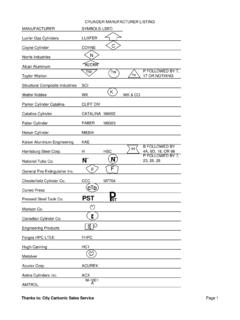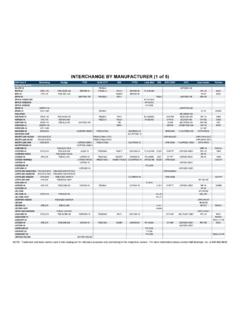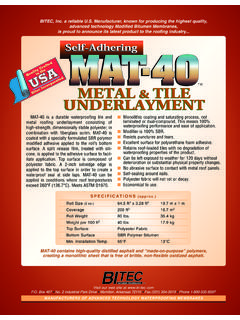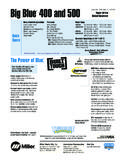Transcription of Germane (GeH ) Safety Data Sheet - metaloids
1 Germane (GeH4) Safety Data Sheet ; Released: May 31, 2015; Supersedes all MSDS versions. SECTION 1 PRODUCT AND COMPANY INFORMATION SECTION 2 HAZARD IDENTIFICATION For emergency assistance (accident, fire, vandalism, exposure, or leak): Contact PERS-ER 1-800-633-8253 in North America, 801-629-0667 from overseas or visit Manufacturer: Metaloid Precursors, Inc. 226 Metro Drive, Metrocrest Industrial Park, Terrell, TX 75160-9169, Tel: +1 972-563-2010, Fax: +1 972-692-5486, - Product Family: Group 4A Metal Hydrides Product Name: Germane (GeH4) Synonyms: Germanium hydride, monogermane, germanomethane, tetrahydridogermanium, germylene. Recommended Uses: Germanium precursor in thin films and silicon-germanium (SiGe) alloy hetero-structures. Classification of the substance GHS Classification in accordance with 29 CFR 1910 (OSHA HCS) H220 Flammable gases (Category 1) H280 Gases under pressure (Compressed gas) H330 Acute toxicity, Inhalation (Category 2) Pictogram: Flammable Gas Gas Under Pressure Acute Toxicity (by inhalation) - Health Hazard GHS Label elements, including precautionary statements Hazard statements H220: Extremely flammable gas.
2 H229: Pressurized container: may burst if heated H280: Contains gas under pressure; may explode if heated. H331: Toxic if inhaled. Precautionary statements P210: Keep away from heat/sparks/open flames/hot surfaces. - No smoking. P260: Do not breathe fume/ gas/ vapor/ spray. P264: Wash skin thoroughly after handling. P270: Do not eat, drink or smoke when using this product. P271: Use only outdoors or in a well-ventilated area. P284: Wear respiratory protection. P304 + P340: IF INHALED: Remove victim to fresh air and keep at rest in a position comfortable for breathing. P310: Immediately call a POISON CENTER or doctor/ physician. P320: Specific treatment is urgent (see first aid instructions). P377: Leaking gas fire: Do not extinguish, unless leak can be stopped safely. P381: Eliminate all ignition sources if safe to do so. P403 + P233: Store in a well-ventilated place.
3 Keep container tightly closed. P405: Store locked up. P410 + P403: Protect from sunlight. Store in a well-ventilated place. P501: Dispose of contents/ container to an approved waste disposal plant. Germane - Safety Data Sheet Released: May 31, 2015; Supersedes all MSDS versions. Page 2 of 5 SECTION 3 COMPOSITION/INFORMATION ON INGREDIENTS SECTION 4 FIRST AID MEASURESSECTION 5 FIREFIGHTING MEASURESP hysical Hazard: Flammable Gases - Category 1 - Extremely flammable gas. Contains gas under pressure; may explode if heated. Can form explosive mixtures with air. Health Hazards: Acute toxicity, inhalation - Category 2 Fatal if inhaled. Specific Target Organ Toxicity - Repeated Exposure (Category 2) May causes damage to organs (kidney and liver) through prolonged or repeated exposure. Environmental Hazards: None Precautionary statements Prevention: Do not handle until all Safety precautions have been read and understood.
4 Do not breathe fumes or mist. Use only outdoors or in a well-ventilated area. In case of inadequate ventilation wear respiratory protection. Keep away from heat/sparks/open flames/hot surfaces. - No smoking. Keep container tightly closed. Use explosion-proof electrical/ ventilating/ lighting/ equipment. Use only non-sparking tools. Take precautionary measures against static discharge. Wear protective gloves/ eye protection/ face protection. Response: In case of leakage: Eliminate all ignition sources. Leaking gas fire: Do not extinguish, unless leak can be stopped safely. In case of leakage, eliminate all ignition sources if safe to do so. If inhaled: Remove person to fresh air and keep comfortable for breathing. Immediately get medical attention. Specific treatment is urgent (see First Aid on this label) If exposed or concerned: CALL A POISON CENTER.
5 Manufacturer/supplier or the competent authority to specify the appropriate source of emergency medical advice Storage: Store in a well-ventilated place. Keep container tightly closed. Store in a well-ventilated place. Keep cool. Store locked up. Protect from sunlight. Keep container tightly closed. Store locked up. Disposal: Dispose of contents/ container to an approved waste disposal plant. HNOC:* None Supplemental Info: None * Hazards not otherwise classified (HNOC) or not covered by GHS Component CAS Number Composition Germanium tetrahydride 7782-65-2 100% Inhalation: Remove the affected person from the gas source or contaminated area. Personal Protective Equipment (PPE), including positive pressure, self-contained breathing apparatus, may be required to assure the Safety of the rescuer.
6 If the affected person is not breathing spontaneously, administer rescue breathing. If the affected person does not have a pulse, administer CPR. If medical oxygen and appropriately trained personnel are available, administer 100%oxygen to the affected person. Keep the affected person warm, comfortable, and at rest while awaiting first responders. Seek medical assistance immediately. Skin Contact: Flush with a copious stream of water while removing contaminated clothing. Immediately contact a physician. Continue flushing for no less than fifteen minutes. Treat thermal burns by flushing with cool water to assure that affected area is cool, then applying dry sterile dressings. Obtain professional medical assistance immediately. Eye Contact: Flush continuously with clean water until the professional medical assistance arrives, but for no less than thirty minutes.
7 Continuation of flushing until patient is transferred to an ophthalmologist or emergency physician is recommended. Ingestion: Ingestion is not an expected route of exposure to gaseous hazardous materials. Chronic Effects: None is known. Note to Physicians: Exposure to Germane responds to diuresis, hemodialysis, peritoneal dialysis and exchange transfusions. Extinguishing Media: None. Germane - Safety Data Sheet Released: May 31, 2015; Supersedes all MSDS versions. Page 3 of 5 SECTION 6 ACCIDENTIAL RELEASE MEASURESSECTION 7 HANDLING AND STORAGESECTION 8 EXPOSURE CONTROL AND PERSONAL PROTECTION Fire Fighting Instructions: The only safe way to extinguish a flammable gas fire is to stop the flow of gas. If the flow cannot be stopped safely, allow the entire contents of the cylinder to burn.
8 Cool the cylinder and surroundings with water from a safe distance. Extinguishing the fire without stopping the flow of gas may permit the formation of ignitable, toxic and explosive mixtures with air. These mixtures may propagate to a source of ignition. Excessive pressure may develop in gas cylinders exposed to fire, which may result in explosions. Cylinders with pressure relief devices (PRD's) may release their contents through such devices if the cylinder is exposed to fire. Cylinders without PRD's have no provision for controlled release and are therefore more likely to explode if exposed to fire. Positive pressure, self-contained breathing apparatus is required for all fire-fighting involving hazardous materials. Full structural fire-fighting gear is the minimum acceptable. The need for proximity, entry, and flashover protection and special protective clothing should be determined for each incident by a competent firefighting Safety professional.
9 Flammability and Explosivity: Germane gas can propagate a decomposition flame in the absence of air at subsonic rates to form hydrogen gas (pressure hazard) and germanium, and release heat. Known or Anticipated Hazardous Products of Combustion: Germanium oxide, hydrogen, steam. Properties that may Initiate or Intensify Fire: Heating cylinder to the point of activation of the pressure relief device or to the point of initiating thermal decomposition. Reactions which Release Flammable Gases: Decomposition of Germane releases hydrogen (fire/overpressure hazard). Containment: As this material is a gas at atmospheric conditions, the only means of containment is the enclosure of the space into which the material is released. Such containment is described in Section 7. Clean Up: Clean up consists of passing the entire gas volume of the enclosure through appropriate exhaust gas treatment equipment (EGTE).
10 Purge the enclosure with a non-reactive gas, such as nitrogen, through the EGTE until an acceptably low level of contamination remains. Equipment contaminated by this material must then be cleaned or decommissioned appropriately. Evacuation: If the release is not contained in an appropriate device or system, all personnel not appropriately protected (see Section 8) must evacuate the contaminated spaces. Consider evacuation of additional areas, as a precaution against the spread of the release or subsequent explosion or fire. Special Instructions: As leaks will not auto ignite, consider the possible formation of ignitable or explosive mixtures with air. Handling: Handle this material only in sealed, purged systems. Consider the use of doubly-contained piping; diaphragm or bellows sealed, soft seat valves; backflow prevention devices; flash arrestors; and flow monitoring or limiting devices.







